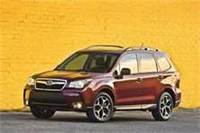2014 Subaru Forester Aces Tough New Crash Test; Earns New IIHS 2013 Top Safety Pick+ Rating
 |
- All-new The 2014 Subaru Forester is the first vehicle to ace every aspect of the challenging small overlap front crash test conducted by the Insurance Institute for Highway Safety
- Forester is also the only small SUVs to earn an overall rating of good in the test
CHERRY HILL, NJ--May 16, 2013: Subaru of America, Inc. today announced that the all-new 2014 Forester has received a Top Safety Pick+ (TSP+) award from the Insurance Institute for Highway Safety (IIHS). The 2014 Subaru Forester is the first vehicle to ace every aspect of the challenging small overlap front crash test conducted by the IIHS. The Forester is the only one of 13 small SUVs to earn an overall rating of good in the test. This is not the first time that the Forester has stood out in a new IIHS crash test. When the Institute first rated small SUVs for side protection in 2003, the Subaru model performed the best and was one of only two vehicles to earn good ratings.
"With the redesigned Forester, Subaru's engineers set out to do well in our new test, and they succeeded," says Joe Nolan, the Institute's vice president for vehicle research. "This is exactly how we hoped manufacturers would respond to improve protection for people in these kinds of serious frontal crashes."
This award builds on Subaru's safety reputation and is the first IIHS designation for 2014 model year Subaru vehicles. Subaru is the only manufacturer with 2013 IIHS Top Safety Pick for all models and the only brand with IIHS Top Safety Picks for all models for four years running (2010-2013). The 2014 Forester is the third Subaru vehicle to earn the TSP+ award. The 2013 Subaru Legacy and Subaru Outback (built after August 2012) were awarded the Institute's 2013 TSP+ designation in late-2012. The award requires a "Good" or "Acceptable" rating in the Institute's new small overlap frontal crash test in addition to meeting the base "TSP" award criteria.
"Safety is one of our brand tenets and so we are extremely proud to have earned a TSP+ rating for Forester and a third Top Safety Pick+ rating for our brand," said Thomas J. Doll, president and chief operating officer, Subaru of America, Inc. "The Forester is the most award winning small SUV in America and now we have another designation for this venerable vehicle."
About IIHS
The Institute's frontal crashworthiness evaluations are based on
results of a moderate overlap frontal and small overlap crash test. Each
vehicle's overall evaluation is based on measurements of intrusion into the
occupant compartment, injury measures recorded on a 50th percentile male
Hybrid III dummy in the driver seat, and analysis of slow-motion film to
assess how well the restraint system controlled dummy movement during the
test.
Building on its long-running vehicle ratings program for consumer information, IIHS introduced the small overlap test in 2012 to further improve occupant protection in frontal crashes. Most automakers design their vehicles for good performance in the IIHS moderate overlap frontal test and the federal government's full-width frontal test, but many haven't addressed the problem of small overlap crashes. In a 2009 IIHS study of vehicles with good ratings for frontal crash protection, small overlap crashes accounted for nearly a quarter of the frontal crashes involving serious or fatal injury to front seat occupants.
The small overlap test is a demanding crash that replicates what happens when the front corner of a car collides with another vehicle or an object like a tree or utility pole. In the test, 25 percent of a car's front end on the driver side strikes a 5-foot-tall rigid barrier at 40 mph.
Side evaluations are based on performance in a crash test in which the side of a vehicle is struck by a barrier moving at 31 mph. The barrier represents the front end of a pickup or SUV. Ratings reflect injury measures recorded on 2-instrumented SID-IIs dummies representing a small (5th percentile) woman, assessment of head protection countermeasures, and the vehicle's structural performance during the impact.
Rear crash protection is rated according to a two-step procedure. Starting points for the ratings are measurements of head restraint geometry -- the height of a restraint and its horizontal distance behind the back of the head of an average size man. Seat/head restraints with good or acceptable geometry are tested dynamically using a dummy that measures forces on the neck. This test simulates a collision in which a stationary vehicle is struck in the rear at 20 mph. Seats without good or acceptable geometry are rated poor overall because they can't be positioned to protect many people.
In the roof strength test, a metal plate is pushed against 1 side of a roof at a constant speed. To earn a good rating for rollover protection, the roof must withstand a force of 4 times the vehicle's weight before reaching 5 inches of crush. This is called a strength-to-weight ratio. For an acceptable rating, the minimum required strength-to-weight ratio is 3.25. A marginal rating value is 2.5. Anything lower than that is rated poor.


